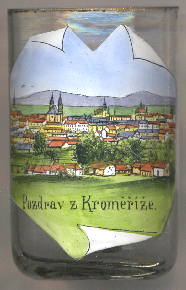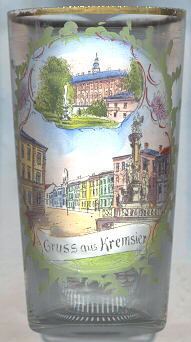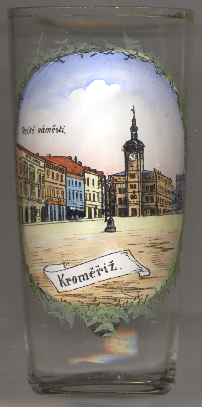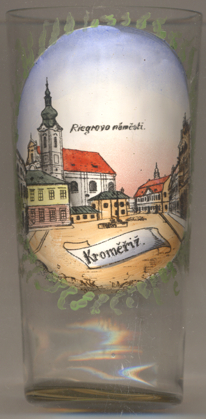

|
| ČESKÁ REPUBLIKA | CZECH REPUBLIC |
| Zlínský kraj | Zlín region |
| Okres: Kroměříž |
 Kroměříž is situated at an elevation of 215 m on the river Morava (March) in southern Moravia.
Already in the 9th/10th century it was the site of a castle erected by the Greater Moravian empire to protect a ford across the river.
The old castle lost its importance when a new castle at Přerov (Prerau) was built by the Přemyslide kings of Bohemia.
Kroměříž was granted the rights of a town around 1260 by the bishops (1588 prince bishops, 1777 archbishops) of
Olomouc (Olmütz) who had chosen Kroměříž as a residence place.
Towards the end of the Thirty Years' War (1618–1648) Kroměříž was occupied and looted twice by Swedish troops.
After the war, the bishops decided to rebuild Kroměříž as a residence town in early Baroque style.
In 1870 the town became autonomous and thus had the same status as Brno (Brünn),
Jihlava (Iglau), Olomouc (Olmütz) and Znojmo (Znaim).
Kroměříž is situated at an elevation of 215 m on the river Morava (March) in southern Moravia.
Already in the 9th/10th century it was the site of a castle erected by the Greater Moravian empire to protect a ford across the river.
The old castle lost its importance when a new castle at Přerov (Prerau) was built by the Přemyslide kings of Bohemia.
Kroměříž was granted the rights of a town around 1260 by the bishops (1588 prince bishops, 1777 archbishops) of
Olomouc (Olmütz) who had chosen Kroměříž as a residence place.
Towards the end of the Thirty Years' War (1618–1648) Kroměříž was occupied and looted twice by Swedish troops.
After the war, the bishops decided to rebuild Kroměříž as a residence town in early Baroque style.
In 1870 the town became autonomous and thus had the same status as Brno (Brünn),
Jihlava (Iglau), Olomouc (Olmütz) and Znojmo (Znaim).

The  episcopal château [top] was created in early Baroque style in the late 17th century by
the architects Filiberto Luchese and Giovanni Pietro Tencalla after the old Gothic and Renaissance castle had been destroyed in the Thirty Years' War.
After a fire in 1752 the château was rebuilt. The château with its tower (68 m high) has become the landmark of Kromìříž.
When the Constituent Assembly of the Austrian Nations had to flee from Vienna during the year of the Revolution of 1848,
it met in the château of Kroměříž to discuss a new constitution for the Austrian empire. The assembly was dissolved, however, in 1849.
In 1885, the château was the site of a meeting between Emperor Franz Joseph I of Austria and Czar Alexander II.
The château also houses one of the most important historical libraries of the Czech Republic and a famous music collection, both from the end of the 17th century.
episcopal château [top] was created in early Baroque style in the late 17th century by
the architects Filiberto Luchese and Giovanni Pietro Tencalla after the old Gothic and Renaissance castle had been destroyed in the Thirty Years' War.
After a fire in 1752 the château was rebuilt. The château with its tower (68 m high) has become the landmark of Kromìříž.
When the Constituent Assembly of the Austrian Nations had to flee from Vienna during the year of the Revolution of 1848,
it met in the château of Kroměříž to discuss a new constitution for the Austrian empire. The assembly was dissolved, however, in 1849.
In 1885, the château was the site of a meeting between Emperor Franz Joseph I of Austria and Czar Alexander II.
The château also houses one of the most important historical libraries of the Czech Republic and a famous music collection, both from the end of the 17th century.
The château gardens, originally created as a Baroque garden, were later redesigned to become a landscape park (64 hectares).
The so-called flower gardens were created in the late 17th century outside the town's fortifications in the style of Italian gardens on an area of 10 hectares
with a gallery (244 m long) with statues of antique gods and heroes and a central fountain. A new entrance with a court of honour and
two large greenhouses were added in the first half of the 19th century.
In 1998, the château and the parks of Kroměříž were listed as a World Cultural Heritage by the UNESCO
(see also list of other UNESCO heritage sites).
The Baroque  Trinity column [bottom right]
was erected in 1725 to commemorate the Plague of 1715–1716.
Trinity column [bottom right]
was erected in 1725 to commemorate the Plague of 1715–1716.

The  old Town Hall [left, no. 4813], located in a corner of
Velké náměstí (Great Square), was built sometime before 1572, when it was first mentioned.
In 1593 it already existed in the form that we know today. In 1850 the city council moved to the General House on the
square and the district governor's office and court moved to the town hall. On that occasion, a third floor was built
into the attic, the folded staircase was removed and the façades were modified. After 1945, the building underwent
extensive reconstruction, which restored it to its older appearance. In 1963, when the celebrations of the 700th anniversary
of the founding of the city took place, the general reconstruction of the town hall was completed. The two-flight staircase
was rebuilt and the arcade was opened, where for centuries there had been small shops. The building today serves as the seat
of the city council and the mayor, deputy mayors , as well as some departments, such as finance, services and tourism, or
legal, and several other parts of the city office. Weddings and some other social events are held in the building.
old Town Hall [left, no. 4813], located in a corner of
Velké náměstí (Great Square), was built sometime before 1572, when it was first mentioned.
In 1593 it already existed in the form that we know today. In 1850 the city council moved to the General House on the
square and the district governor's office and court moved to the town hall. On that occasion, a third floor was built
into the attic, the folded staircase was removed and the façades were modified. After 1945, the building underwent
extensive reconstruction, which restored it to its older appearance. In 1963, when the celebrations of the 700th anniversary
of the founding of the city took place, the general reconstruction of the town hall was completed. The two-flight staircase
was rebuilt and the arcade was opened, where for centuries there had been small shops. The building today serves as the seat
of the city council and the mayor, deputy mayors , as well as some departments, such as finance, services and tourism, or
legal, and several other parts of the city office. Weddings and some other social events are held in the building.
[https://cs.wikipedia.org/wiki/Krom%C4%9B%C5%99%C3%AD%C5%BEsk%C3%A1_radnice]

The  Church of the Assumption of the Virgin Mary [left, no. 4517, and right, no. 4813]
was originally built in 1247. The original church was devastated in completely burnt in 1643 during the Thirty Years'
War by Swedish troops. Only the core of the tower and bare walls remained from the church. The church was then rebuilt
in 1724.
Church of the Assumption of the Virgin Mary [left, no. 4517, and right, no. 4813]
was originally built in 1247. The original church was devastated in completely burnt in 1643 during the Thirty Years'
War by Swedish troops. Only the core of the tower and bare walls remained from the church. The church was then rebuilt
in 1724.
[https://cs.wikipedia.org/wiki/Kostel_Nanebevzetí_Panny_Marie_(Kroměříž)]
 Riegrovo náměstí ('Rieger Square'),
depicted in the foreground, is named for František Ladislav Rieger
(b. 1818 Semily, d. 1903 Prague),
a Czech politician and publicist made famous for his leadership of the early Czech nationalist movement.
Riegrovo náměstí ('Rieger Square'),
depicted in the foreground, is named for František Ladislav Rieger
(b. 1818 Semily, d. 1903 Prague),
a Czech politician and publicist made famous for his leadership of the early Czech nationalist movement.
[https://en.wikipedia.org/wiki/František_Ladislav_Rieger, https://cs.wikipedia.org/wiki/František_Ladislav_Rieger]

The view depicted on glass no. 4517 [near left] shows the junction of
 Milíčovo
Milíčovo 1. maje
1. maje Kollárova
Kollárova
[https://cs.wikipedia.org/wiki/Mil%C3%AD%C4%8D_z_Krom%C4%9B%C5%99%C3%AD%C5%BEe;
https://cs.wikipedia.org/wiki/J%C3%A1n_Koll%C3%A1r]
![[scale]](lineal.jpg)